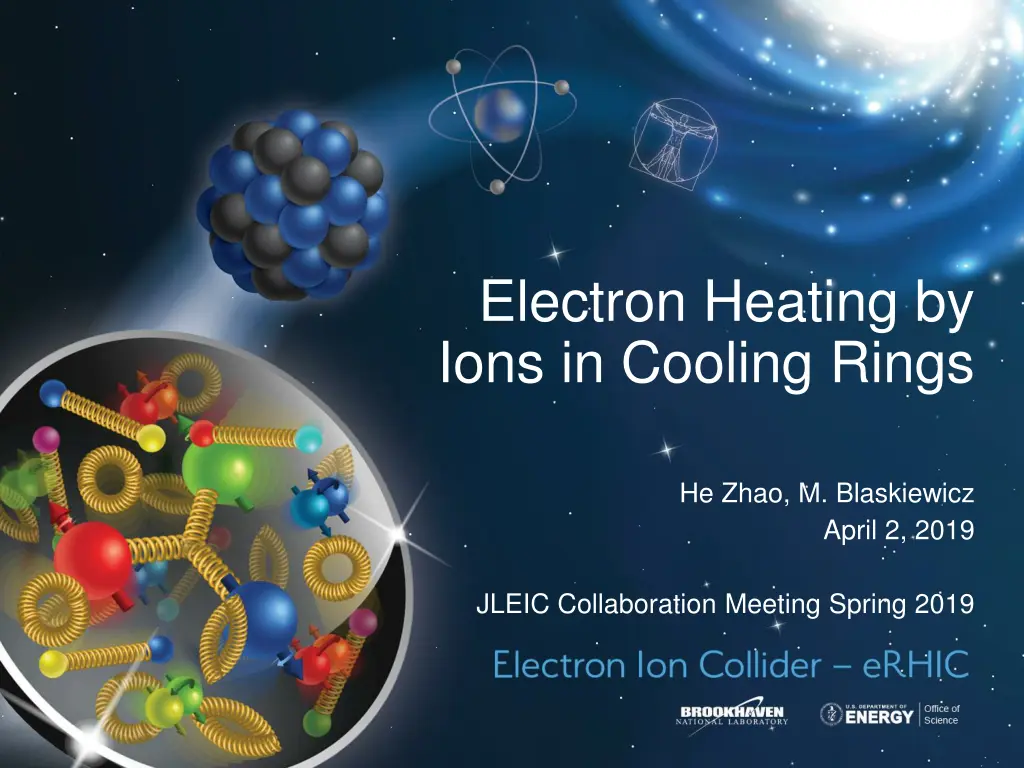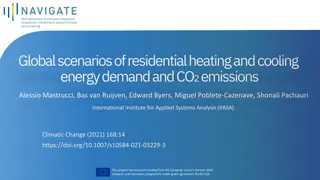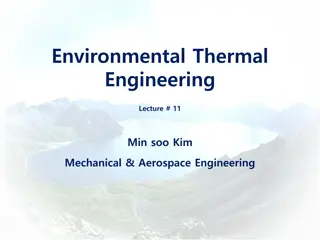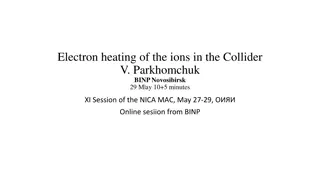
Understanding Electron Heating by Ions in Cooling Rings
Explore the concept of electron heating by ions in cooling rings, including topics like Spitzer formula, kinetic theory, and beam cooling. Learn about calculations, cooling effects, and the interaction between electrons and ions.
Uploaded on | 0 Views
Download Presentation

Please find below an Image/Link to download the presentation.
The content on the website is provided AS IS for your information and personal use only. It may not be sold, licensed, or shared on other websites without obtaining consent from the author. If you encounter any issues during the download, it is possible that the publisher has removed the file from their server.
You are allowed to download the files provided on this website for personal or commercial use, subject to the condition that they are used lawfully. All files are the property of their respective owners.
The content on the website is provided AS IS for your information and personal use only. It may not be sold, licensed, or shared on other websites without obtaining consent from the author.
E N D
Presentation Transcript
Electron Heating by Ions in Cooling Rings He Zhao, M. Blaskiewicz April 2, 2019 JLEIC Collaboration Meeting Spring 2019
Outline Background Cooling for EIC Cooling & heating Electron Beam Heating by Ions Spitzer formula Kinetic theory (gas model) Calculations IBS Summary 2
Cooling Ring Beam cooling - Storage ring with high energy, high power electron beam. - <2 hour cooling rate with bunched electron beam. - The IBS effect is the most important heating effect in the ion beam. E-beam quality - The single bunch e-beam will interact with ions many turns instead of once. - Heating: IBS, heating by ions, space charge - Cooling: synchrotron damping 3
Cooling & Heating effect cooling Cooling Magnetic cooling force (Parkhomchuk s formula) IBS IBS Non-magnetic cooling force heating Intra-Beam Scattering Piwinski, Martini, B-M and Jie-Wei model Nagaitsev model (considered dispersions and simplified the integration) Coupling effect in transverse E-beam heating by ions 1. How to calculate the electron heating rate (model)? 2. How large of it comparing with IBS effect? 4
Spitzer Formula Based on energy exchange between electrons and ions Maxwellian velocity distribution with different kinetic temperature Ti , Te 3??(4??0)2 8???2?2?e(2?)1/2(??e ??? ??=?? ?? ?+??? ?)3/2 ???= ??? E-beam heating rate by ion ???,? ??,???= ???,?????,?? 1 ???? The temperature of the beam in each dimension is independent. ?( ? ?)2 Only good for the beam (electron and ion) with same temperature in 3D. ??//??// 1 ???? = ( ? ?)2?? 5
Calculation with heating Ion (proton) electron Only electron heating effect in the calculation. ? = 293.1 3.1e-9 3.1e-9 9e-4 0.263 5e10 ? = 293.1 2.0e-9 2.0e-9 7.5e-4 0.07 1.2e11 Energy _x (rad.m) _y(rad.m) dp/p Bunch length (m) N Both ion and electron beam have the same temperature in each dimension. The heating rate in each dimension keeps the same during the evolution. Temprature: Ion: 0.833/0.833/0.778 keV Electron: 0.29/0.29/0.28 eV Rate (s-1) The ion beam keeps no change Turns Turns 6
Kinetic theory ?(?,?,?,??,??, ??,t): Distribution function: ?? ??= ? ?+ ? ? + ? ? Boltzmann transport equation: ?= ?(?) Diffusion (freely moving) External force (electromagnetic field) Collision (between particles) ?? ?= Only consider the collision between a and b ??? ? Coulomb collision operator ??,?=?2??,? ???? ?3 ?? ?? ?? ?? ) ???=??? ?? ?? ?3? ??,?(?? ?? ?? 2?? 2?? 2?? 4??0 2 ???=?? 2 2 ?? The heating rate ?3? ?? 2?? ???2= ?? Gas heating 7
Gas Heating Rate 2??= ?3? ? ???2 ?? =??? ?3? ?3? {?2 ?? 2 ??2 ??? ??2 ??? ???? ?3 ???? ??? ???? ??? 2 ???? ???? ??? ???? ??? 2}??? ??(? ) 2 ?3 ?3 =??? ?3? ?3?{?2 ?? 2 ???? ?3 2 ???? 2 2}??? ??(? + ?) ?3 ?3 Here we consider the beam in 6-D phase space is independent and Gaussian distribution. No coupling in the cooling section and no beam rotates in phase space. 2 2 ??2 2??? ??2 2??? ?? 2??? ?0 ? ? = Exp( 2 2) 2?3????????? ?2 2?? ?2 2?? ?2 2??2 = n0Exp ?2 2?? ?2 2?? ?2 2??2 ? ? ?,?,? = 2?3??????Exp 2 2 2 2 8
Gas Heating Rate ????0? 2??= ?3?{ ?? 2?3???????????????????????? ?2 ?? ?3 ???? 2???? ???? ?3 ???? 2???? ???? ?3 ???? 2???? 2 1 2 1 1 1 1 1 1 ?( , ,??,2) ?( , ,??,0) ?( 2, 2,??,0) 2 2 2 2 2???? 1 2???? 1 2???? 2???? 1 2???? 1 2???? 2???? 1 2???? 1 2???? 2???? 1 2???? 1 2???? 2???? 1 2???? 1 2???? 1 2 1 ?( , ,??,1) ?( , ,??,1) ?( 2, 2,??,0) 2 2 2 2 1 2?( 1 , ,??,1) ?( , ,??,0) ?( 2, 2,??,1)} 2 2 2 2 ? ?? ?? ? + ??2) ??exp ? ? + ?2 ??2?? ? ?,?,?,1 = ? + ?exp( ? ?,?,?,? = ? + ? ?2?2 ? + ?2] ? ?? 1 ? ?? ? + ??2) ? + ??2) ? ?,?,?,0 = ? + ?exp( ? ?,?,?,2 = [ + ? + ?exp( 2 ? + ? 9
Calculation with heating Same temperature (3D) of ion and electron Ion (proton) electron ? = 293.1 3.1e-9 3.1e-9 9e-4 0.263 5e10 ? = 293.1 2.0e-9 2.0e-9 7.5e-4 0.07 1.2e11 Energy _x (rad.m) _y(rad.m) dp/p Bunch length (m) N Spitzer model vs. gas model A little difference between the two models Ion: 0.833/0.833/0.778 keV Electron: 0.29/0.29/0.28 eV Rate (s-1) 10
Calculation with heating Different temperature (3D) of electron Ion (proton) electron ? = 293.1 3.1e-9 3.1e-9 9e-4 0.263 5e10 ? = 293.1 2.0e-9 8.0e-9 5.0e-4 0.07 1.2e11 Energy _x (rad.m) _y(rad.m) dp/p Bunch length (m) N Spitzer model vs. gas model These two models are consistent with each other Ion: 0.833/0.833/0.778 keV Electron: 0.29/1.17/0.13 eV Rate (s-1) 11
Calculation with heating Large temperature difference of electron Ion (proton) electron ? = 293.1 3.1e-9 3.1e-9 9e-4 0.263 5e10 ? = 293.1 5.0e-8 2.0e-9 1.0e-3 0.07 1.2e11 Energy _x (rad.m) _y(rad.m) dp/p Bunch length (m) N The heating rate in horizontal is negative, which means cooling effect on the electron beam. cooling? Ion: 0.833/0.833/0.778 keV Electron: 7.30/0.29/0.51 eV Rate (s-1) 12
Calculation with heating e- Large temperature difference of electron The heating rate in horizontal is negative, which means cooling effect on the electron beam. p The heating rates in spitzer model should be always positive because the high tem. of ion beam. ??? ??=?? ?? ??? 3??(4??0)2 8???2?2?e(2?)1/2(??e ?+??? ?)3/2 ???= The negative heating rate is reasonable. The gas model is good for the heating calculation Are these calculation believable? 13
IBS calculation (gas model) ?? ?= ??? (Collisions between electrons) Boltzmann transport equation: ? ?3? ??,?(?? ?? ?? ?? ???=??? ?? ) ?? ?? 2 Very simple model, no beam rotate in phase space, no dispersion and coupling etc. Heating rate caused by IBS: ??????,?,? 2?3???? ?2 ?? ?3 ???? ???? ?3 ???? ???? ?3 ???? 2??= 2 ?3?{ ?? 2???? 1 2 ?( 2???? 1 2???? 1 2???? 1 2???? 2 1 1 1 1 1 , ,??,1) ?( , ,??,0) ?( 2, 2,??,0) 2 2 2 2 2???? 1 2???? 1 2???? 2???? 1 2???? 1 2???? 2???? 1 2???? 1 2???? 2???? 1 2???? 1 2???? 2???? 1 2???? 1 2???? 1 2 ?( , ,??,1) ?( , ,??,0) ?( 2, 2,??,0) 2 2 2 2 1 2?( , ,??,1) ?( , ,??,0) ?( 2, 2,??,0)} 2 2 2 2 14
IBS calculation (gas model) Compared with the Nagaitsev s IBS model. Only one point of a ring (? = 295?,? = 0,? = 0) The result is acceptable even though a little difference with Nagaitsev s model. _x _y dp/p Nagaitsev_x Gas_IBS_x Nagaitsev_y Gas_IBS_y Nagaitsev_s Gas_IBS_s 2.00E-09 2.00E-09 7.50E-04 -0.8 -1.6 -0.8 -1.6 1.7 3.367 5.00E-09 2.00E-09 7.50E-04 -11.3 -18.9 12.3 23.03 14 26.43 1.00E-09 2.00E-09 7.50E-04 100 187.7 -26.8 -49 -23.8 -43.07 2.00E-09 2.00E-09 1.00E-04 -102 -183 -102 -183 11894 21548 2.00E-09 2.00E-09 1.00E-03 12.6 23.33 12.6 23.3 -14.6 -26.3 The gas heating model is good and reliable. 15
How large of electron heating rate by ions? The IBS heating rate is the average value of the ring lattice (Nagaitsev s model). Only gas heating rate is applied on beam in the simulation. The heating rate by ions can reach to 10% of the IBS heating rate in longitudinal, and it determined by the beam status. Ion (proton) electron Ion (proton) electron ? = 293.1 3.1e-9 3.1e-9 9e-4 0.263 5e10 ? = 293.1 2.0e-9 8.0e-9 5.0e-4 0.07 1.2e11 Energy _x (rad.m) _y(rad.m) dp/p Bunch length (m) N ? = 293.1 3.1e-9 3.1e-9 9e-4 0.263 5e10 ? = 293.1 2.0e-9 2.0e-9 7.5e-4 0.07 1.2e11 Energy _x (rad.m) _y(rad.m) dp/p Bunch length (m) N 16
How large of electron heating rate by ions? The IBS heating rate is the average value of the ring lattice (Nagaitsev s model). Only gas heating rate is applied on beam in the simulation. The heating rate by ions can reach to 10% of the IBS heating rate in longitudinal, and it determined by the beam status. The electron beam status in cooling rings is mainly depended on the synchrotron damping, IBS and heating by ions. So, these effects should be considered seriously to study the electron beam quality, as well as cooling rate. More works should be done in the future for the determination of electron beam parameters and cooling simulation. 17
Summary The electron beam heating by the ions was studied, and a good model is established for the calculation of the heating rate. Comparing with IBS, we think this heating effect could be an important factor to affect the electron beam quality. In the future, the heating by ions, synchrotron damping and IBS should be carefully considered for the estimation of electron beam parameters and cooling rate calculations. 18
Acknowledgement This work is based on M. Blaskiewicz s idea and previous work. Thanks to the suggestions and discussions from M. Blaskiewicz and A. Fedotov. References Landau and Lifshitz, Physical Kinetics, Course of Theoretical Physics vol.10. Lyman Spitzer, Jr. Physics of Fully Ionized Gases, second edition. R. D. Hazeltine, Coulomb Collision Operator, 2006. 19






















